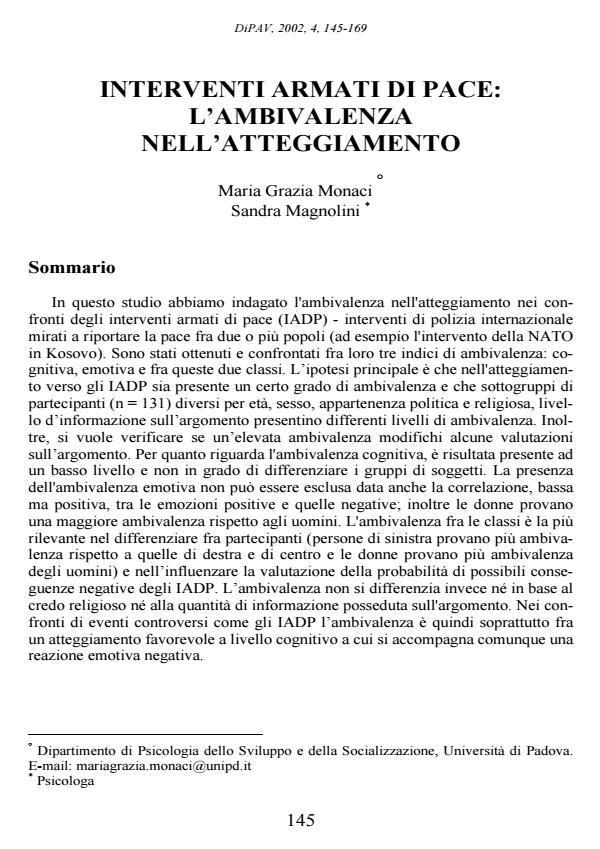Interventi armati di pace: l'ambivalenza nell'atteggiamento
Titolo Rivista DiPAV - QUADERNI
Autori/Curatori Maria Grazia Monaci, Sandra Magnolini
Anno di pubblicazione 2003 Fascicolo 2002/4
Lingua Italiano Numero pagine 25 P. Dimensione file 371 KB
DOI
Il DOI è il codice a barre della proprietà intellettuale: per saperne di più
clicca qui
Qui sotto puoi vedere in anteprima la prima pagina di questo articolo.
Se questo articolo ti interessa, lo puoi acquistare (e scaricare in formato pdf) seguendo le facili indicazioni per acquistare il download credit. Acquista Download Credits per scaricare questo Articolo in formato PDF

FrancoAngeli è membro della Publishers International Linking Association, Inc (PILA)associazione indipendente e non profit per facilitare (attraverso i servizi tecnologici implementati da CrossRef.org) l’accesso degli studiosi ai contenuti digitali nelle pubblicazioni professionali e scientifiche
This study explores ambivalence in the attitude toward the international military interventions to restore peace (IADP) for instance the Nato in-tervention in Kosovo. Three indexes of cognitive, emotive and between these two classes ambivalence have been calculated and compared. The main hypothesis is that a certain degree of ambivalence is present in the attitude toward the IADP and that groups of participants (n = 131) differ-ent for gender, age, political and religious beliefs, level of information will show different level of ambivalence. Furthermore, we want to verify whether a high degree of ambivalence modifies some evaluations on the topic. As regard as cognitive ambivalence results show that it is present at a low level and do not differentiate among groups of participants. The presence of emotional ambivalence cannot be excluded even because of the correlation, low but positive, between positive and negative emotions; fur-thermore women feel greater emotional ambivalence than men. Ambiva-lence between the two classes is the most relevant in differentiating groups of participants (leftist feel more ambivalence than centrist and rightist and women more than men) and influencing the evaluations of probability of possible IADP negative consequences. Ambivalence is however not differ-ent for people with different level of information on the topic or religious beliefs. Toward controversial events such as the IADP, ambivalence is therefore particularly present between a favourable attitude at a cognitive level and negative emotional response.
Maria Grazia Monaci, Sandra Magnolini, Interventi armati di pace: l'ambivalenza nell'atteggiamento in "DiPAV - QUADERNI" 4/2002, pp , DOI: